

Designation:Southern Cross Light Veritech Cycles
|
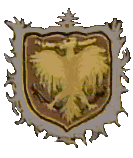
|
||||
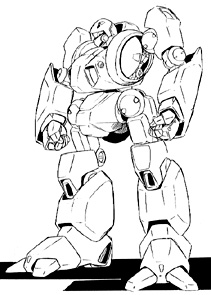
|
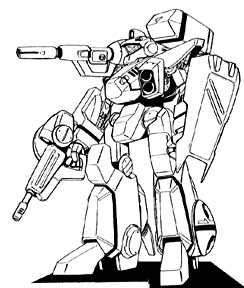
|
||||
| MODAT/Garland | Strike Garland* | Hargun | Space Hargun | ||
|---|---|---|---|---|---|
| Height, Battloid: | 3.85 | 3.73 | 3.96 | 3.96 | m |
| Depth, Battloid: | 1.72 | 1.72 | 1.80 | 2.75 | m |
| Breadth, Battloid: | 2.60 | 2.60 | 2.50 | 2.50 | m |
| Length, cycle: | 3.96 | 4.42 | 2.85 | -- | m |
| Width, cycle: | 1.90 | 1.90 | 0.88 | -- | m |
| Height, cycle: | 1.20 | 1.20 | 1.20 | -- | m |
| Weight: | 880/895 | 917 | 930 | 1100 | kg |
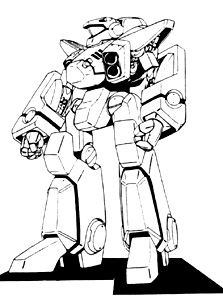 *Note: The dimensions given for the Strike Garland are without the optional
shoulder-mounted weapons, as in the image to the right.
*Note: The dimensions given for the Strike Garland are without the optional
shoulder-mounted weapons, as in the image to the right.
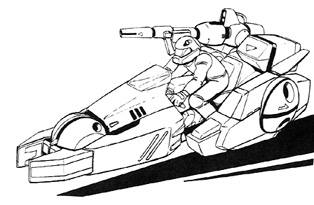
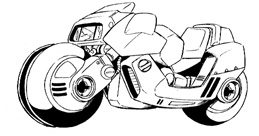
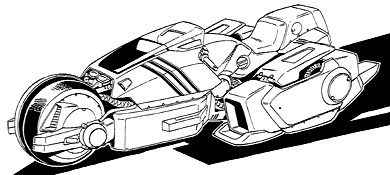
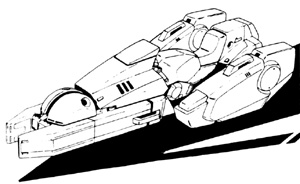
(Typical - any Hargun/Garland can carry any of the hand-held weapons, but may not be able to integrate them into the transformation sequence. The exception is the EP-45, which can fire only from the Strike Garland due to its demand on the internal energy system.)
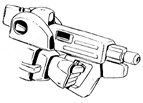

The armor of the Hargun and MODAT is composed of a plastic-ceramic composite for maximal resistance to penetration and thermic explosive damage for minimal weight. The armor stops all small arms fire, provides fair to good protection against heavier infantry weapons, such as a 12.7mm machinegun round, and poor to fair resistance to light mecha-mounted weaponry, such as the Zentraedi 22.3mm HE autocannon round. The armor on the MODAT is marginally better than that on the Hargun
The armor of the Garland and Strike Garland is composed of an advanced titanium-steel alloy. The armor stops all small arms fire, provides good protection against heavier infantry weapons, such as a 12.7mm machinegun round, and fair resistance to light mecha-mounted weaponry, such as the Zentraedi 22.3mm HE autocannon round. The armor is marginally inferior to that mounted on the contemporary Logan.
The armor on the parrying shield issued standard with the Hargun and Strike Garland is made of a low-mass Chobham, similar in composition and protection to the main armor on the AGACS. The shield magnetically mounts to the left arm.
All these vehicles provide full protection from nuclear, biological, and chemical hazards in Battloid mode, using an overpressure cockpit environment activated by radiation and hazardous chemical sensors, or manually when biological warfare conditions are anticipated. The internal consumables supplies can provide atmosphere for six hours maximum, except for the Space Hargun, whose tanks can hold two days' worth of life support.
Note that the above armor data assumes that the pilot is himself wearing some sort of body armor; a heavy weapon hit to the cockpit area may result in shrapnel being released into the vehicle, injuring an unarmored occupant. In cycle mode the pilot rides unprotected from the elements and incoming fire on top of the vehicle.
As the Southern Cross contemplated the future of its significant investment in infantry units, its generals began to lament the relative impotency of even the best-equipped infantryman against armor and mecha. Using the exact same rationalization as the REF would in the development of the Cyclone, the Southern Cross began to develop light ground Veritechs as well.
The result was a series of Veritech motorcycles based around a common torso concept. Unlike the REF's Cyclone, the pilot of these mecha was fully enclosed in armor in Battloid mode, and the unit was a true mecha, not a battlesuit.
The result of the preliminary studies was the Hargun Combat Cycle. The torso prototype was finalized in 2020, but at this time the engineers were still having trouble developing the collapsible arms and legs. As a stopgap solution for the prototype, a special utility truck was developed for the Hargun. The Hargun operator would drive into the utility vehicle, where the arms and legs would be attached while the motorcycle transformed into a a torso, and the entire mecha would be lifted into a standing position. Despite the cumbersome transformation sequence, the Hargun was a strong, quick, light Battloid. Its 32mm gun pod was a little underpowered, but would still be very effective against full-sized Zentraedi. The Global Military Police was so impressed with it that they ordered several thousand built, to be stationed in urban centers around the globe, with the understanding that they would be refit to fully transformable versions as soon as the new limbs were available. As it happened, the new limbs would require extensive redesigns on the torso itself to mate to it, and the Veritech version of the Hargun soon became a dead end. However, it was still a valuable Battloid, and because of the inability for the Battloid to quickly enter a battle without the unarmed and poorly armored service vehicle, the GMP ordered a heavier version of their combat Hoverplatform that could drop the Battloid Hargun into a firefight, while using its own guns to suppress enemy resistance. The Harguns and their delivery vehicles first entered service in 2025.
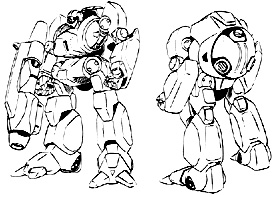
In anticipation of the fully transformable MODAT, all Harguns were eventually fitted with a new head (including 4 light welding lasers), a space-thruster backpack, and the GU-11S 55mm carbine. These refits, called the Space Hargun, were transferred to the Tactical Space Corps (with transformation switch disabled) beginning in 2027, and served the TSC in areas of support, lunar patrol, maintenance, and light combat duty until the Invid invasion.
Meanwhile, engineers had managed to solve the problems that plagued
the transforming limbs, and went to developing the first fully-transformable
descendant of the Hargun. At the same time, the Battloid head was upgraded,
and the torso redesigned to accommodate the limbs. Furthermore, the first
five fully-functional prototypes, or the MODAT 1 through 5, as they came to
be called (Mobile Operations Data Access Terminal), were also equipped with
a high-speed uplink to the SDF-1's main computer, the E.V.E., which had
been transferred to the Robotech Research Center in Tokyo. During testing
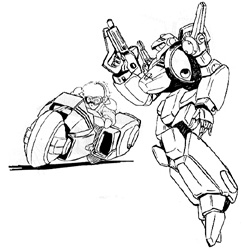 of the Harguns, pilots reported problems with removing the bikes from
blocked streets without recourse to the battloid mode. A self-powered
reverse was included in the new designs and, as these mecha were to be
used for urban defence and riot control, they were given enough power to remove
a medium-sized roadblock from their path. The MODAT was armed with the even more inadequate
GU-18 23mm gun pod because the GU-19 was far too large to fit into the
transformation sequence. Only five MODAT
prototypes were ever built. The first four were impounded and were either
destroyed or were well hidden by Colonel Andrews weeks before his
abortive coup in the Far East. The MODAT 5 was stolen in January 2029
and was destroyed under mysterious circumstances.
of the Harguns, pilots reported problems with removing the bikes from
blocked streets without recourse to the battloid mode. A self-powered
reverse was included in the new designs and, as these mecha were to be
used for urban defence and riot control, they were given enough power to remove
a medium-sized roadblock from their path. The MODAT was armed with the even more inadequate
GU-18 23mm gun pod because the GU-19 was far too large to fit into the
transformation sequence. Only five MODAT
prototypes were ever built. The first four were impounded and were either
destroyed or were well hidden by Colonel Andrews weeks before his
abortive coup in the Far East. The MODAT 5 was stolen in January 2029
and was destroyed under mysterious circumstances.
Despite the political embarrassment surrounding the MODAT 5's destruction, its utility was obvious. Two new programs were approved. The Garland was to be developed as an upgrade of the MODAT 5, sans computer uplink, and was to be armed with the far more formidable GU-21 45mm recoilless rifle. The head optics were improved, and the legs were redesigned to include additional thrusters. The Garland entered service in 2029, and several hundred were delivered to the GMP-EC and the ASC-CDU before war's end.
In addition, another derivative of the MODAT 5 was the Strike Garland, which was a hovercycle. It refit the thrusters in the back of the torso, essentially retained the MODAT 5 legs, but redesigned the shoulders to include the forward hoverbanks. The primary weapon was to be the EP-40 pulse beam gun, which was to remedy the problem of under-powered guns. This "Hover-Garland", as it is often called, was to make up for the ineffectiveness with which the Garland negotiated broken terrain, but the mecha became much more power-intensive. The Strike Garland only began to be produced by the end of the Second Robotech War, and immediately after the war, with the impending thread of the Invid, the decision was made to up-arm the Strike Garland. In addition to an optional fuel and thruster pack attached to the legs, two hardpoints were added to the shoulders, one for a missile launcher, the other for the devastating EP-43 85mm pulse laser, which was to be powered by its own dedicated protoculture cell. Where the Harguns, MODAT 5, and Garland were all designed for ESWAT police duties and civil defense, the Strike Garland was primarily conceived to be a front-line light combat mecha. By the time of the Invid invasion, two hundred and sixty of the Strike Garland had been built and issued to the Tactical Corps' 1st Mechanized Division.
Very few Garlands or Harguns survived the Invid occupation, though they were vastly more powerful than the REF Cyclone, and were coveted by resistance fighters. After the battle of Reflex Point, the Garland programs were revived. The Garland II took the legs from the Garland, upgraded the torso and arms of the Strike Garland, and sported a new head. This system could use all the weapons developed for the Garland series, and would be issued a payload dependent on the nature of the mission. In the year 2050, the Garland II was acquired by the Terran Marines and Army under the new name "Tempest Combat Cycle", and served with distinction in many conflicts.
Go to the Light Veritech Cycle Image Gallery.
Return to Southern Cross Index
Go to Robotech Reference Guide Home Page
Robotech (R) is the property of Harmony Gold. This document is in no way intended to infringe upon their rights.
Content by Peter Walker and Pieter Thomassen, with Rob Morgenstern
HTML by Robert Morgenstern (rmorgens@ieee.org)